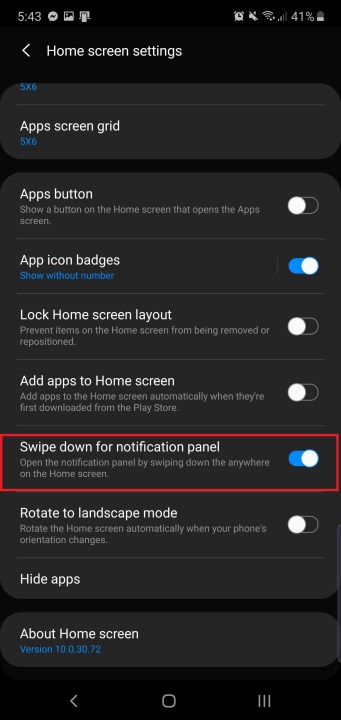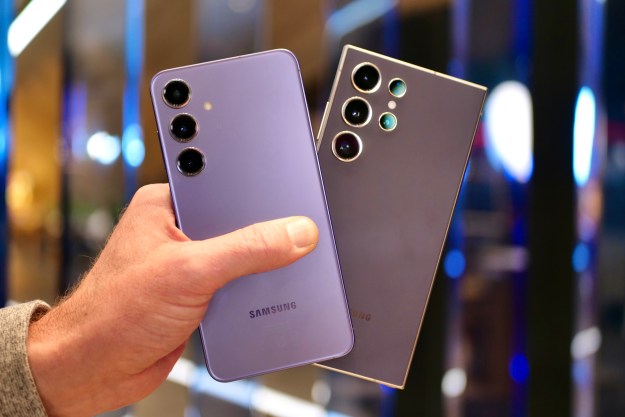Samsung’s Galaxy Note 10 and Note 10 Plus are packed to the brim with features and we detail some of the highlights in our in-depth reviews. But many of these tricks are hidden, or confusingly turned off by default. From maxing out the screen resolution to swiping down anywhere to access the notification drawer, we’ve rounded up all the key settings to change to get the most out of your new phone.
- Change the power button
- Max the screen resolution
- Fix the navigation bar layout
- Swipe down to access notifications
- Show more notifications on the status bar and the battery percentage
- Add dynamic wallpapers, app shortcuts to the lock screen
- Use the volume keys for media, turn on Dolby Atmos
- Turn on the blue-light filter and night mode
- Turn on Face Unlock
- Always show the Always On Display
- Toggle on Lift to wake, Smart Stay
Before we start, there are two ways you can access the Settings menu: Swipe down to lower the notification drawer and tap the gear icon on the top right. Alternatively, you can find the Settings app in the app drawer.
Change the power button
There are only two buttons on the Note 10 and
How do you turn off the phone, then? Swipe down the notification drawer and you’ll see a new power icon next to the gear icon. Tap it to get power options so you can restart or turn off your phone. Don’t worry — there’s a way to make the button do this if you don’t like the software option.
Go to Settings > Advanced features > Side key, and under Press and hold, tap Power off menu. Now you’ll get the traditional power menu when you press and hold the side key.
Here you can also see that it’s possible to customize the double-press function. By default, it opens the camera, but you can have it launch
Max the screen resolution
The
Head to Settings > Display > Screen resolution and choose WQHD+ 3,040 x 1,440. Do note that this will increase the drain on the battery, so if you want to conserve battery life, keep the resolution at the default (or lower it to 1,520 x 720).
The smaller 6.3-inch
Fix the navigation bar layout
If you’re a lifelong Samsung
If you want to change the layout to the standard
When the Note 10 and
Swipe down to access notifications
The
It’s hidden away in the home screen settings menu. Tap and hold on the home screen, and tap on the icon on the far left titled Home screen settings. Look for Swipe down for notification panel, and toggle it on. Now if you swipe down anywhere on the home screen, the notification drawer will come down, so you don’t need to reach for the top of the screen. This won’t work while in an app, though.
Show more notifications on the status bar and the battery percentage
By default, the Note 10 range will show you the three most recent app notifications in the status bar — you’ll need to swipe down to see all of them. But if you want to see more apps, it’s possible by heading to Settings > Notifications > Status bar and tapping on All notifications. You’ll still be limited to around five apps as that’s what space allows.
Here, you can also see the option to show the battery percentage next to the battery icon for more precise measurements. Simply toggle it on and you’ll see the percentage pop up on the far right of the status bar.
Add dynamic wallpapers, app shortcuts to the lock screen
The Note 10 and
Speaking of the lock screen, there’s also a feature that lets you add app shortcuts when you tap on the in-display fingerprint sensor. It’s in the same settings menu — Settings > Lock screen > App shortcuts — and choose Floating button. Traditionally, lock screen app shortcuts sit on the bottom corners of the screen (this option is still available), but the new option hides them until you unlock the phone with the in-display fingerprint sensor.
Choose a Left shortcut and a Right shortcut, and you’ll see these apps pop up as you press the fingerprint sensor. Slide your finger to one to open it.
Use the volume keys for media, turn on Dolby Atmos
Ever have a moment when you tap on a video and your phone starts blasting sound at loud volumes, much to your chagrin? If nothing happened when you pressed the volume buttons, that’s because by default they control ringtone volume. In the Settings > Sounds and vibrations menu, you can toggle on Use Volume keys for media to make it so that the volume rocker will prioritize controlling media volume by default.
While you’re here, you should take a second to toggle on Dolby Atmos. It makes the audio coming out of your Note phone sound a lot better, and you can find it in Settings > Sounds and vibrations > Advanced sound settings > Sound quality and effects >
Turn on the blue-light filter and night mode
Like most smartphones, the Note 10 range has a blue-light filter you can turn on at night. Studies show that taking in blue light before bed can have adverse effects on your health, so it’s a good idea to limit exposure as much as possible. Head to Settings > Display > Blue light filter to toggle it on. You can choose whether to turn it on from sunset to sunrise or schedule a specific window of time. You can also tweak the intensity of the filter to make the screen more or less yellow.
The Note 10 and
Turn on Face Unlock
If you’re not a fan of the in-display fingerprint sensor, you’ll be happy to know there’s an alternative unlocking method on the Note 10 and
You can customize the feature to take you straight to the home screen by toggling off Stay on Lock screen. We recommend turning off Faster recognition as well, as leaving it on makes face unlock less secure.
Always show the Always On Display
The Always-on Display lets you look at the time and incoming notifications on the phone’s standby screen without having to pick it up. But by default, you need to tap the screen to show the Always-on Display. You can keep it permanently on, just note it may use up a little more battery life.
Head to Settings > Lock screen > Always On Display > and tap the Show always option. Now you’re set! You can also set it to turn on permanently at a certain time, if that’s your preference.
Pro tip: You can customize the look of the always-on display by going to Lock screen > Clock style > Always on Display.
Toggle on Lift to wake, Smart Stay
Simply grabbing the Note 10 and
One feature that’s toggled off is Smart Stay — it’s been available on Samsung phones for several years. It makes sure the screen stays on while you keep looking at it, so toggle it on if you find the screen frequently shuts off while you’re reading.
Editors' Recommendations
- Best Samsung Galaxy S22 deals: Save big on unlocked models
- The 20 best Samsung Galaxy Watch faces you should be using
- The best Samsung Galaxy S24 Plus cases in 2024: our 13 favorites
- Have one of these Samsung phones? You’re getting Galaxy AI features next month
- The best Samsung Galaxy S23 Plus cases in 2024: the 17 best ones































